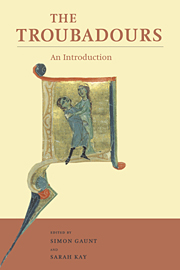Book contents
- Frontmatter
- Contents
- List of contributors
- Preface
- Map of Occitania and neighbouring Catalonia
- Introduction
- 1 Courtly culture in medieval Occitania
- 2 Fin'amor and the development of the courtly canso
- 3 Moral and satirical poetry
- 4 The early troubadours: Guilhem IX to Bernart de Ventadorn
- 5 The classical period: from Raimbaut d'Aurenga to Arnaut Daniel
- 6 The later troubadours
- 7 The trobairitz
- 8 Italian and Catalan troubadours
- 9 Music and versification
- 10 Rhetoric and hermeneutics
- 11 Intertextuality and dialogism in the troubadours
- 12 The troubadours at play: irony, parody and burlesque
- 13 Desire and subjectivity
- 14 Orality and writing: the text of the troubadour poem
- 15 The chansonniers as books
- 16 Troubadour lyric and Old French narrative
- Appendix 1 Major troubadours
- Appendix 2 Occitan terms
- Appendix 3 Research tools and reference works
- Appendix 4 The chansonniers
- Bibliography
- Index
15 - The chansonniers as books
Published online by Cambridge University Press: 05 June 2012
- Frontmatter
- Contents
- List of contributors
- Preface
- Map of Occitania and neighbouring Catalonia
- Introduction
- 1 Courtly culture in medieval Occitania
- 2 Fin'amor and the development of the courtly canso
- 3 Moral and satirical poetry
- 4 The early troubadours: Guilhem IX to Bernart de Ventadorn
- 5 The classical period: from Raimbaut d'Aurenga to Arnaut Daniel
- 6 The later troubadours
- 7 The trobairitz
- 8 Italian and Catalan troubadours
- 9 Music and versification
- 10 Rhetoric and hermeneutics
- 11 Intertextuality and dialogism in the troubadours
- 12 The troubadours at play: irony, parody and burlesque
- 13 Desire and subjectivity
- 14 Orality and writing: the text of the troubadour poem
- 15 The chansonniers as books
- 16 Troubadour lyric and Old French narrative
- Appendix 1 Major troubadours
- Appendix 2 Occitan terms
- Appendix 3 Research tools and reference works
- Appendix 4 The chansonniers
- Bibliography
- Index
Summary
The thirteenth-century troubadour manuscripts are among the earliest known collections of lyric poetry in a European vernacular and the first in Occitan to treat secular rather than religious works. With their large number and variety of songs, frequent emendations, attention to distinctions of genre and attribution, consciousness of literary history, and comprehensive plans for rubrication, they proclaim their double status as book, rather than mere compendium, and art object, worthy of collection. Prized from the outset, multiple copies were often made from the same source (for example AA′ and the Auvergnat B, or the important series IKK′K″) or sometime later in cheaper editions (such as a, a copy on paper of the Bernart Amoros chansonnier). Both the Italian and slightly later Languedocian codices served as models for the Italian lyric collections of the fourteenth century and as source books for Italian poets, including Dante and Petrarch, and the Occitan anthologist-critic Matfre Ermengaud. Indeed, Occitan poetry and French romances were in demand at the Northern Italian courts throughout the thirteenth and fourteenth centuries as badges of aristocratic legitimacy (Krauss, Epica feodale).
There are forty chansonniers extant. The earliest of them (the group dated from 1254 to approximately 1300) were either produced in the workshops of Venice, Padua and Treviso, often by Occitan scribes (AIKDDaHST), or brought to Italy shortly there-after (as in the case of V, and the original from which a was copied). More than 50 per cent of those dating from the fourteenth century were likewise made in Northern Italy. In the wake of Napoleon's grand conquest and the nascent nationalism that followed, Romantic critics undertook the systematic study of these rediscovered treasures.
Information
- Type
- Chapter
- Information
- The TroubadoursAn Introduction, pp. 246 - 262Publisher: Cambridge University PressPrint publication year: 1999
Accessibility standard: Unknown
Why this information is here
This section outlines the accessibility features of this content - including support for screen readers, full keyboard navigation and high-contrast display options. This may not be relevant for you.Accessibility Information
- 1
- Cited by
